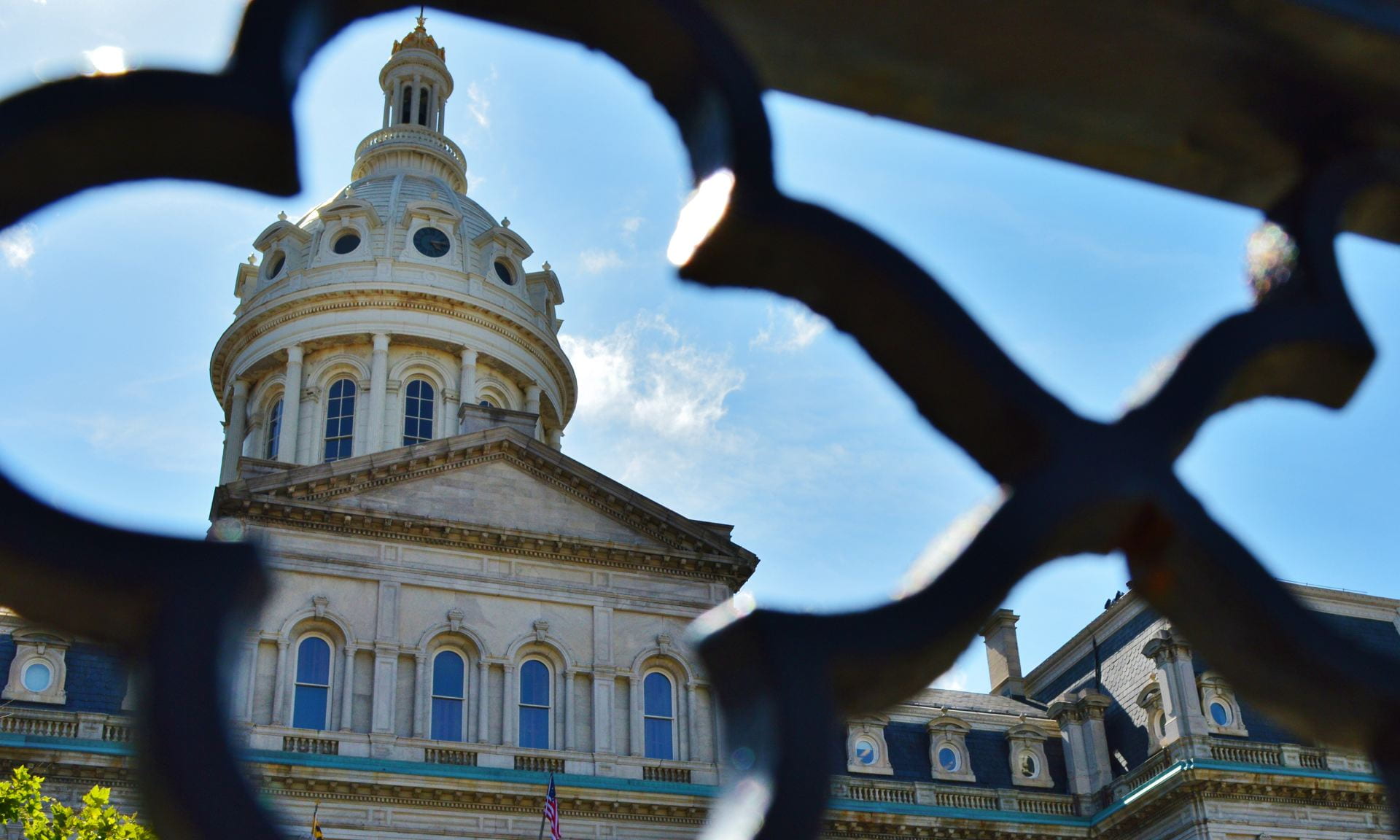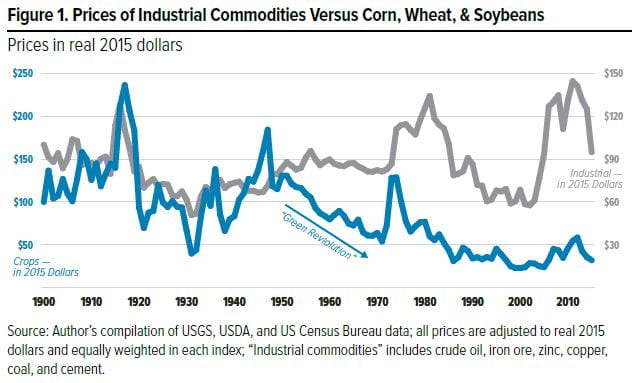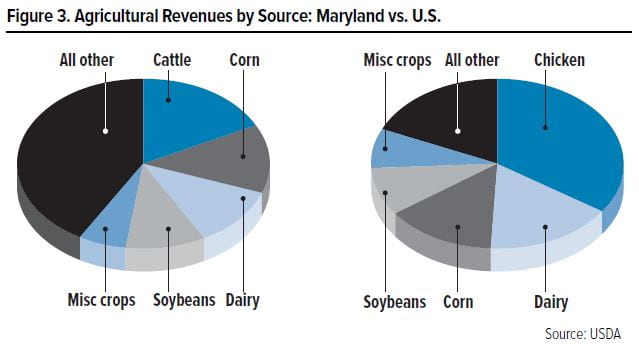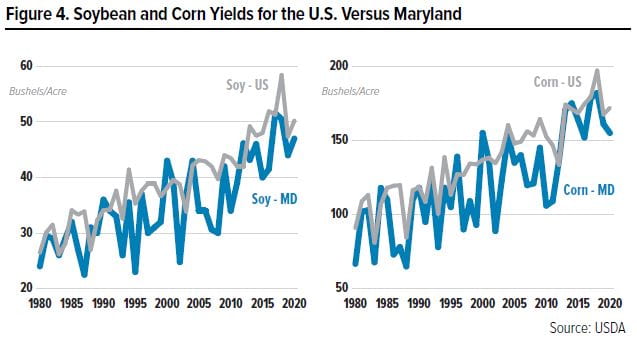Vincent Anderson, CFA
Director, Equity Research, Stifel Financial Corp.
Laura Wood
Agriculture & Outreach Coordinator, ShoreRivers
Despite Maryland’s population growing nearly 30%
since 1990, with accompanying rapid development of
residential areas, agriculture remains an important part
of much of the state’s local economy and culture. Within
Maryland, the economic, cultural, and environmental
impact of farming is perhaps no greater than on the
Eastern Shore. Much of the state and its visitors may
only give a passing glance to the swathes of corn and
soybeans on their way to the iconic Chesapeake Bay
or Atlantic shores. But despite the predominance of
farmland, the Eastern Shore struggles to support its
agricultural heritage amid volatile crop markets and
pressure to protect the health of the Chesapeake Bay
and its watersheds. Luckily, there are organizations
that have risen to the challenge of preserving both the
environment and Maryland’s agriculture.
Global Row Crop Markets: A Historical Perspective
Historically, row crop prices have suffered from the
deflationary impact of technological advancement in
the form of steadily improving yields. Beginning with
the postwar proliferation of chemical fertilizers and
mechanized equipment, yields (crop output per unit of
land area) in the U.S.—and elsewhere in the world—have
largely outpaced demand growth. The result has been
a decoupling of inflation-adjusted crop prices from
traditional “industrial” commodities such as energy
products, non-precious metals, etc. For perspective, the
significant appreciation in energy and metals prices in
response to the China-led commodity super-cycle of
the 2000s contrasts with row crops’ much more muted
response (Figure 1).
Crop prices tend to be less sensitive than industrial
commodities to economic cycles because demand is
more stable, tracking population growth and household
incomes. Given this, higher crop prices typically require a
supply-side push, either from a decline in acreage (capacity)
or yields (utilization). As with any large fixed cost base,
profitability is heavily tied to the utilization of the fixed
asset (land, equipment). So it is unsurprising that global
crop yields have marched steadily higher for decades as
farmers look to maximize the value of their operations
(Figure 2). Knowledge of best practices; advances in farm
machinery, soil testing, and crop monitoring; and new
technologies in crop protection chemicals and seed
genetics have all contributed to increasing output per
acre. The result has been long inventory cycles, which
slowly influence the growth in new acreage.
Maryland’s Agricultural Economy at a Glance
Maryland’s agricultural sector amounted to $2.2 billion—
only 1.3% of the state’s 2018 gross domestic product.
However, the agricultural economy’s health remains
essential to the state’s rural population because 82.6%
of Maryland’s more than 12,000 farm organizations are
individual/family sole proprietorships. Of those, less than
25% generate more than $50,000 per year in revenue
despite nearly 50% of the state’s farm operators listing
agriculture as their principal occupation.
A higher percentage of Maryland’s rural population
fails to complete at least high school (11.7% vs. 9.5%
in urban areas). The rural population also experiences
higher poverty rates (12.3% vs. 9.0% in urban areas) and
a median income 13.4% lower than urban households
and 33.5% lower income per job worked. Compared to
national averages, Maryland’s rural population comes
out slightly ahead in areas such as income and education
disparity. Some of the gap is potentially explained by the
relatively higher population density of the state versus
other rural communities, providing more opportunities
for nonfarm income sources. Additionally, many farms in
Maryland generate nonagricultural income via services
such as hunting rights, horse boarding, etc. However,
the data still underscores the challenges facing one of
the state’s higher-risk demographics.
The composition of Maryland’s agricultural economy is
unique. While row crops are generally its most visible
representation, poultry (particularly chickens) is the state’s
largest source of agricultural revenues (Figure 3). With
Perdue Farms’ strong presence in the area incentivizing
local production, poultry markets have offered a solid
revenue source, diversified from row crops, and with good
local demand. This supplement is important, given the
comparatively low share of Maryland farmland dedicated
to pastureland and high-value livestock/dairy operations.
If farmers across the U.S. have faced economic challenges
from a decade of low crop prices, how have Maryland
farmers fared? Maryland farmers have shown remarkable
resiliency when their average yields for the state’s
primary row crops, corn and soybeans, are compared
to national averages (Figure 4). While naturally a smaller
subset of geography will display greater volatility than
the national average, particularly from weather disruption,
on a whole Maryland has performed well over the
past few decades, averaging just 10% lower yields on
soybeans and 12% lower yields on corn since 1980.
This relatively strong performance has been achieved
despite Maryland farmers operating an average farm
size of just 160 acres versus the national average of
441 acres, greater distance from key supply chains
(mainly the Mississippi and other tributary systems that
connect much of our grain and fertilizer shipping to the
“breadbasket” states). In Maryland, the average farm size
has remained the same since 2007, while average farm
size nationally has increased 5.5% from 2007–2017
(most recent available data). Consolidation has been a
key theme and is important to owner-operated efforts
to increase fixed-cost leverage, particularly on equipment,
as farm rent values (a cost for non-owner operated
farms) have remained stubbornly high despite lower crop
prices. Maryland’s geography—unlike the large open
expanses of the Midwest—has likely contributed to its
more fragmented operations. Moreover, its proximity to
attractive Mid-Atlantic real estate markets has created
competing nonagricultural bids for farmland.
Agriculture and Conservation: A Delicate Balance
Farming is a critical industry, given its role in feeding
the masses. Accordingly, governments worldwide have
worked throughout history to protect their domestic
agriculture through subsidies and direct intervention in
agriculture markets. In fact, so-called “bread riots” have
long been a topic of discussion in political science and
geopolitics, to the extent that rapid food price inflation
has contributed to political upheaval. For example, some
historians estimate that bread as a share of the average
working-class citizen’s daily wages rose over 30% in the
run-up to the French Revolution. More recently, the Arab
Spring uprising coincided with significant increases in
food inflation that the government of Egypt, at the time,
was unwilling to offset with increased subsidies. During
China’s African swine fever outbreak, which led to the
deaths of over 50% of its swine herds, the government
released strategic reserves of pork. This was partly due
to pork’s cultural significance, despite the shortage not
carrying any material nutrition risks to the population.
During the COVID-19 outbreak, global grain traders saw
increased demand for basic agriculture commodities into
areas that rely on imports to meet domestic caloric needs.
Given both lagging farmer incomes and the political
importance of food supplies, efforts to address real concerns
over issues, such as water pollution, can struggle
to gain traction. In some cases, these efforts compete
indirectly with programs that seek to preserve land for
agriculture by buying real estate development rights,
keeping land that may otherwise be uncompetitive in
agricultural production and providing little incentive
for farmers to contribute capital to improve nutrient
management and run-off controls. Partly as a result,
official estimates of farmland in conservation programs,
both in absolute terms and as a share of total farm acres,
has declined, both nationally and in Maryland. However,
nonprofits and corporations within the agriculture value
chain continue to work toward alternative programs to
reduce the environmental impact of farming.
Lessons in Farmer/Conservation Cooperation
in Chesapeake Bay: ShoreRivers Example
The Chesapeake Bay is central to Maryland’s identity
and, for much of the state, its culture. This extends far
inland, owing to the watershed’s 150 major rivers and
streams, totaling over 100,000 tributaries. Surrounding
these tributaries on the Eastern Shore, farmers who have
spent generations working the land and enjoying recreation
on the bay are asked to make difficult decisions.
Runoff is a well-known issue in environmental conservation;
rainfall carries waste and materials intended for land
use into waterways where they become pollutants. Many
are likely familiar with the Gulf of Mexico “dead zone,”
the disruption to Gulf Coast fishing and water quality
from run-off flowing down the Mississippi River. Much
of the Chesapeake’s struggles with water quality in the
main stem of the bay are attributed to run-off from the
Susquehanna River. However, the Eastern Shore community
is also facing the need—and an opportunity—to
improve its waterways and their impact on the health
of the Chesapeake. Organizations like ShoreRivers are
working to educate and assist farmers in balancing
the needs of the land with the needs of the local water
system to address these challenges.
Farming and Conservation: Challenges
Plants are no different from other biological life in
needing specific nutrients to grow and survive. However,
growing crops requires a different timeline for nutrition
than do human beings with their decadeslong lives. With
row crops being planted, grown, and harvested in less
than a calendar year, it is paramount that enough of the
right nutrition is available to the plant at the right time
to maximize yields. After over a decade of lagging crop
prices, making changes to agricultural practices that
serve any purpose other than to get maximum production
out of the land can be difficult for farmers to accept.
On the Eastern Shore, the low-lying land, permeated
throughout with tidal rivers, has often struggled with
run-off of all kinds. The prevalence of agricultural land
use there has placed much of the burden on farmers
to address conservation needs. Convincing farmers
of the crucial role they play in bay restoration can be
difficult. Pollution comes from all sectors, and farmers
can sometimes feel overly burdened with the task of
improving local waterways. However, on the Eastern
Shore, agriculture is the largest land-use sector for all
of the rivers’ watersheds. Therefore, agriculture has an
undeniable impact on local waterways and an undeniable
opportunity to improve water quality. Luckily, given
the close cultural ties the local farming community has
to the bay, and with the consistent efforts and sciencedriven
approach of ShoreRivers, the nonprofit has been
successful in working with agricultural stakeholders
on these issues.
Farming and Conservation: Successes
ShoreRivers works to improve the health of Eastern Shore
waterways through science-based advocacy, restoration,
and education. The organization formed in 2017 via the
merger of the Chester River Association, Midshore Riverkeeper
Conservancy, and Sassafras River Association.
As of May 2021, the organization of roughly two dozen
full-time employees had 186 projects (of which 130 are
agricultural) that have diverted over 144,000 pounds of
nitrogen; 17,500 pounds of phosphorus; and 5,000 tons
of suspended solids (sediment) from the waterways. The
group adapted quickly during the pandemic, growing its
project base by over 40% from May 2019 to May 2021.
The organization relies on extensive testing and standardized
water quality grading methods to foster confidence
in its reporting. The transparency of regularly reporting
successful practices and areas needing improvement
lend credibility to its advocacy. In fact, many of the
organization’s projects are inbound requests. Its extensive
testing and reporting of water quality along the region’s
river system have been pivotal in convincing locals that
most of the local water quality issues originate from
their own land use, rather than as an extension of the
broader water quality conditions of the Chesapeake Bay.
ShoreRivers works to position itself as a partner to the
agricultural community by providing technical support,
such as offering engineering assistance when designing
replacements for old, failing drainage systems to
incorporate better run-off controls, and coordinating
financial assistance, such as state and federal cost-share
programs with grants and foundation funds to complete
comprehensive projects that provide for buffer zones
between crop land and waterways. ShoreRivers and
farm partners are also investigating innovative financing
mechanisms to help fund conservation through
outcome-based approaches to leverage private investment.
Employing this collaborative approach paired
with innovative financing, along with its members’ deep
personal connections to the area, have helped drive its
successes.
Looking Ahead
Farmer fortunes have taken a perhaps unexpected turn
since the outbreak of the COVID-19 pandemic; while
economics globally reeled from the impact of shutdowns,
crop prices have risen markedly. Currently, corn and
soybean prices are up over 40% compared with 2019
levels. Weather issues in Brazil, Eastern Europe, and
China, recent changes to biofuel economics, and the
pandemic’s impact on the purchasing patterns of nations
that rely heavily on imported crops have combined
to push prices to levels not seen in years. For farmer
incomes, this has clearly benefited bottom lines. For
conservation efforts, it may require more adaptation.
Higher farm incomes could increase the opportunity cost
to farmers of placing marginal quality land into conservation
programs, but may also spur farmers to invest in
better run-off control infrastructure. Regardless of the
direction of crop markets, organizations like ShoreRivers
will continue to work to improve the quality of local
water systems while preserving Maryland’s agricultural
industry and heritage.




